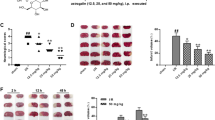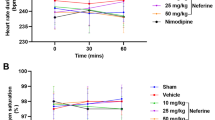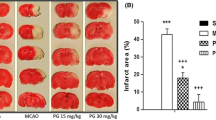Abstract
In the present study, we aimed at evaluating the potential neuroprotective effect and the underlying mechanism of anemonin against cerebral ischemia and reperfusion (I/R) injury. Anemonin was administered to rats by the intraperitoneally (i.p.) route once daily for 7 days before middle cerebral artery occlusion (MCAO). Focal cerebral ischemia was induced by 90 min of MCAO followed by 24 h of reperfusion. After that, animals were sacrificed by decapitation, brain was removed, and various biochemical estimations, neurological status, and assessment of cerebral infarct size were carried out. MCAO followed by 24 h of reperfusion caused a significant increase in infarct size, neurological deficit score, malondialdehyde (MDA) content, reactive oxygen species (ROS) level, and DNA fragmentation, as well as a decrease in the activities of superoxide dismutase (SOD), catalase (CAT), reduced glutathione (GSH), glutathione peroxidase (GPx), and Na+, K+-ATPase in the brain. Furthermore, elevated Bax expression, increased caspase-3 cleavage, and decreased Bcl-2 expression were observed in nontreated rats in response to focal cerebral I/R injury. However, pretreatment with anemonin significantly reversed these levels of biochemical parameters, reduced cerebral infarct size, and improved the neurologic score in cerebral ischemic animals. Additionally, a wide distribution of anemonin in plasma and brain tissues and the brain-to-plasma partition coefficient (Ri) ratio of 0.7 at 90 min indicated that this compound could penetrate the blood-brain barrier (BBB). These results showed that pretreatment with anemonin provided a significant protection against cerebral I/R injury in rats by, at least in part, its antioxidant action and consequent inhibition of apoptosis.







Similar content being viewed by others
References
Beauchamp C, Fridovich I (1971) Super oxide dismutase: improved assays and an assay applicable to acryl amide gels. Anal Biochem 44:276–287
Blaustein MP (1977) Sodium ions, calcium ions, blood pressure regulation, and hypertension: a reassessment and a hypothesis. Am J Physiol 232:C165–173
Bozlu G, Atici A, Turhan AH, Polat A, Nayci A, Okuyaz C, Taskinlar H (2007) Platelet-activating factor antagonist (ABT-491) decreases neuronal apoptosis in neonatal rat model of hypoxic ischemic brain injury. Brain Res 1143:193–198
Braughler JM, Hall ED (1989) Central nervous system trauma and stroke: I. Biochemical considerations for oxygen radical formation and lipid peroxidation. Free Radic Biol Med 6:289–301
Chan PH (2001) Reactive oxygen radicals in signalling and damage in the ischemic brain. J Cereb Blood Metab 21:2–14
Chan PH (2004) Mitochondria and neuronal death/survival signaling pathways in cerebral ischemia. Neurochem Res 29:1943–1949
Claiborne A (1985) Catalase activities. In: Greenwald RA (ed) CRC handbook of methods in oxygen radical research. CRC, Boca Raton, pp 283–284
Cooper JL, Pulsinelli WA, Duffy TE (1980) Glutathione and ascorbate during ischemia and post ischemic reperfusion in rat brain. J Neurochem 35:1242–1245
Coyle JT, Puttfarcken P (1993) Oxidative stress, glutamate, and neurodegenerative disorders. Science 262:689–695
Dietschy JM, Turley SD (2001) Cholesterol metabolism in the brain. Curr Opin Lipidol 12:105–112
Dirnagl U, Lindauer U, Them A, Schreiber S, Pfister HW, Koedel U, Reszka R, Freyer D, Villringer A (1995) Global cerebral ischemia in the rat: online monitoring of oxygen free radical production using chemiluminescence in vivo. J Cereb Blood Flow Metab 15:929–940
Dirnagl U, Ladecola C, Moskowitz MA (1999) Pathobiology of ischaemic stroke: an integrated view. Trends Neurosci 22:391–397
Duan H, Zhang Y, Xu J, Qiao J, Suo Z, Hu G, Mu X (2006) Effect of anemonin on NO, ET-1 and ICAM-1 production in rat intestinal microvascular endothelial cells. J Ethnopharmacol 104:362–366
Easton JD, Hansen SL, Martin JB (1998) Cerebrovascular diseases. In: Fanci AS, Bravnwald E, Isselbacher KJ, Wilson JD, Martin JB, Kasper DL (eds) Principles of internal medicine. McGraw-Hill, New York, p 2325
Engelke M, Diehl H, Tähti H (1992) Effects of toluene and n-hexane on rat synaptosomal membrane fluidity and integral enzyme activities. Pharmacol Toxicol 71:343–347
Furui T, Tanaka I, Iwata K (1990) Alterations in Na(+)-K(+)-ATPase activity and beta-endorphin content in acute ischemic brain with and without naloxone treatment. J Neurosurg 72:458–462
Gilgun-Sherki Y, Rosenbaum Z, Melamed E, Offen D (2002) Antioxidant therapy in acute central nervous system injury: current state. Pharmacol Rev 54:271–284
Globus MY, Alonso O, Dietrich WD, Busto R, Ginsberg MD (1995) Glutamate release and free radical production following brain injury: effects of post-traumatic hypothermia. J Neurochem 65:1704–1711
Gutteridge JM (1995) Lipid peroxidation and antioxidants as biomarkers of tissue damage. Clin Chem 41:1819–1828
Halliwell B, Gutteridge JM (1984) Lipid peroxidation, oxygen radicals, cell damage, and antioxidant therapy. Lancet 1:1396–1397
Harlow L, Lane D (1988) Antibodies: a laboratory manual. Cold Spring Harbor Laboratory, Cold Spring Harbor.
He S, Yang J, Wu B, Pan Y, Wan H, Wang Y, Du Y, Wang S (2010) Neuroprotective effect of parthenocissin A, a natural antioxidant and free radical scavenger, in focal cerebral ischemia of rats. Phytother Res 24:S63–70
Hua F, Ma J, Ha T, Kelley JL, Kao RL, Schweitzer JB, Kalbfleisch JH, Williams DL, Li C (2009) Differential roles of TLR2 and TLR4 in acute focal cerebral ischemia/reperfusion injury in mice. Brain Res 1262:100–108
Huang YH, Lee TH, Chan KJ, Hsu FL, Wu YC, Lee MH (2008) Anemonin is a natural bioactive compound that can regulate tyrosinase-related proteins and mRNA in human melanocytes. J Dermatol Sci 49:115–123
Iadecola C, Zhang F, Casey R, Clark HB, Ross ME (1996) Inducible nitric oxide synthase gene expression in vascular cells after transient focal cerebral ischemia. Stroke 27:1373–1380
Imaizumi S, Kayama T, Suzuki J (1984) Chemiluminescence in hypoxic brain—the first report. Correlation between energy metabolism and free radical reaction. Stroke 15:1061–1065
Itoh J, Nabeshima T, Kameyama T (1990) Utility of an elevated plus maze for the evaluation of memory in mice. Effects of nootropis, scopolamine and electroconvulsive shock. Psychopharmacology 101:27–32
Janardhan V, Qureshi AI (2004) Mechanisms of ischemic brain injury. Curr Cardiol Rep 6:117–123
Jollow DJ, Mitchell JR, Zampaglione N, Gillette JR (1974) Bromobenzene induced liver necrosis: protective role of glutathione and evidences for 3,4-bromobenzene as the hepatotoxic intermediate. Pharmacology 11:151–169
Juurlink BHJ, Sweeney MI (1997) Mechanisms that result in damage during and following cerebral ischemia. Neurosci Biobehav Rev 21:121–128
Kuang X, Yao Y, Du JR, Liu YX, Wang CY, Qian ZM (2006) Neuroprotective role of Z-ligustilide against forebrain ischemic injury in ICR mice. Brain Res 1102:145–153
Kuroda S, Siesjö BK (1997) Reperfusion damage following focal ischemia: pathophysiology and therapeutic windows. Clin Neurosci 4:199–212
LeBel CP, Ischiropoulos H, Bondy SC (1992) Evaluation of the probe 2′,7′-dichlorofluorescin as an indicator of reactive oxygen species formation and oxidative stress. Chem Res Toxicol 5:227–231
Longa EZ, Weinstein PR, Carlson S, Cummins R (1989) Reversible middle cerebral artery occlusion without craniectomy in rats. Stroke 20:84–91
Lowry OH, Rosebrough NJ, Fair AL, Randall RJ (1951) Protein measurement with the Folinphenol reagent. J Biol Chem 193:265–275
Mead JF (1976) Free radical mechanisms of lipid damage and consequence for cellular membranes. In: Pryor WP (ed) Free radicals in biology. Academic, New York, p 55
Merry DE, Korsmeyer SJ (1997) Bcl-2 gene family in the nervous system. Annu Rev Neurosci 20:245–267
Mohandas J, Marshall JJ, Duggin GG, Horwath JS, Tiller D (1984) Differential distribution of glutathione and glutathione related enzymes in rabbit kidneys: possible implication in analgesic neuropathy. Cancer Res 44:5086–5091
Okhawa H, Ohishi N, Yaga K (1979) Assay of lipid peroxides in animal tissue by thiobarbituric acid reaction. Anal Biochem 95:351–358
Oliver CN, Starke-Reed PE, Stadtman ER, Liu GJ, Carney JM, Floyd RA (1990) Oxidative damage to brain proteins, loss of glutamine synthetase activity, and production of free radicals during ischemia/reperfusion-induced injury to gerbil brain. Proc Natl Acad Sci U S A 87:5144–5147
Reed DJ (1990) Glutathione: toxicological implications. Annu Rev Toxicol 30:603–663
Saleem S, Ahmad M, Ahmad AS, Yousuf S, Ansari MA, Khan MB, Ishrat T, Islam F (2006) Effect of saffron (Crocus sativus) on neurobehavioral and neurochemical changes in cerebral ischemia in rats. J Med Food 9:246–253
Sovoboda P, Mossinger B (1981) Catecholamines and brain microsomal Na+, K+-ATPase. Protection against lipoperoxidative damage. Biochem Pharmacol 30:427–432
Toshkov A, Ivanov V, Sobeva V, Gancheva T, Rangelova S, Toneva V (1961) On antibacterial, antiviral, antitoxic and cytopathogenic properties of protoanemonin and anemonin. Antibiotiki 6:918–24
Vogel J, Weigand MA, Behrens A, Wagner EF, Schorpp-Kistner M, Zimmermann M, Schenkel J (2007) Infarct volume after transient middle cerebral artery occlusion (MCAo) can be reduced by attenuation but not by inactivation of c-Jun action. Brain Res 1151:12–19
Wong CH, Crack PJ (2008) Modulation of neuro-inflammation and vascular response by oxidative stress following cerebral ischemia-reperfusion injury. Curr Med Chem 15:1–14
Yousuf S, Salim S, Ahmad M, Ahmed AS, Ansari MA, Islam F (2005) Protective effect of Khamira Abresham Uood Mastagiwala against free radical induced damage in focal cerebral ischemia. J Ethnopharmacol 99:179–184
Yousuf S, Atif F, Ahmad M, Hoda N, Ishrat T, Khan B (2009) Resveratrol exerts its neuroprotective effect by modulating mitochondrial dysfunctions and associated cell death during cerebral ischemia. Brain Res 1250:242–253
Yu XY, Lin SG, Chen X, Zhou ZW, Liang J, Duan W, Chowbay B, Wen JY, Chan E, Cao J, Li CG, Zhou SF (2007) Transport of cryptotanshinone, a major active triterpenoid in Salvia miltiorrhiza Bunge widely used in the treatment of stroke and Alzheimer’s disease, across the blood-brain barrier. Curr Drug Metab 8:365–378
Zhan C, Yang J (2006) Protective effects of isoliquiritigenin in transient middle cerebral artery occlusion-induced focal cerebral ischemia in rats. Pharmacol Res 53:303–309
Zhang J, Huang M, Guan S, Bi HC, Pan Y, Duan W, Chan SY, Chen X, Hong YH, Bian JS, Yang HY, Zhou S (2006) A mechanistic study of the intestinal absorption of cryptotanshinone, the major active constituent of Salvia miltiorrhiza. J Pharmacol Exp Ther 317:1285–1294
Zhao J, Zhao Y, Zheng W, Lu Y, Feng G, Yu S (2008) Neuroprotective effect of curcumin on transient focal cerebral ischemia in rats. Brain Res 1229:224–232
Conflict of Interest
None
Author information
Authors and Affiliations
Corresponding authors
Additional information
D. Jia and B. Han contributed equally to this work.
Rights and permissions
About this article
Cite this article
Jia, D., Han, B., Yang, S. et al. Anemonin Alleviates Nerve Injury After Cerebral Ischemia and Reperfusion (I/R) in Rats by Improving Antioxidant Activities and Inhibiting Apoptosis Pathway. J Mol Neurosci 53, 271–279 (2014). https://doi.org/10.1007/s12031-013-0217-z
Received:
Accepted:
Published:
Issue Date:
DOI: https://doi.org/10.1007/s12031-013-0217-z




